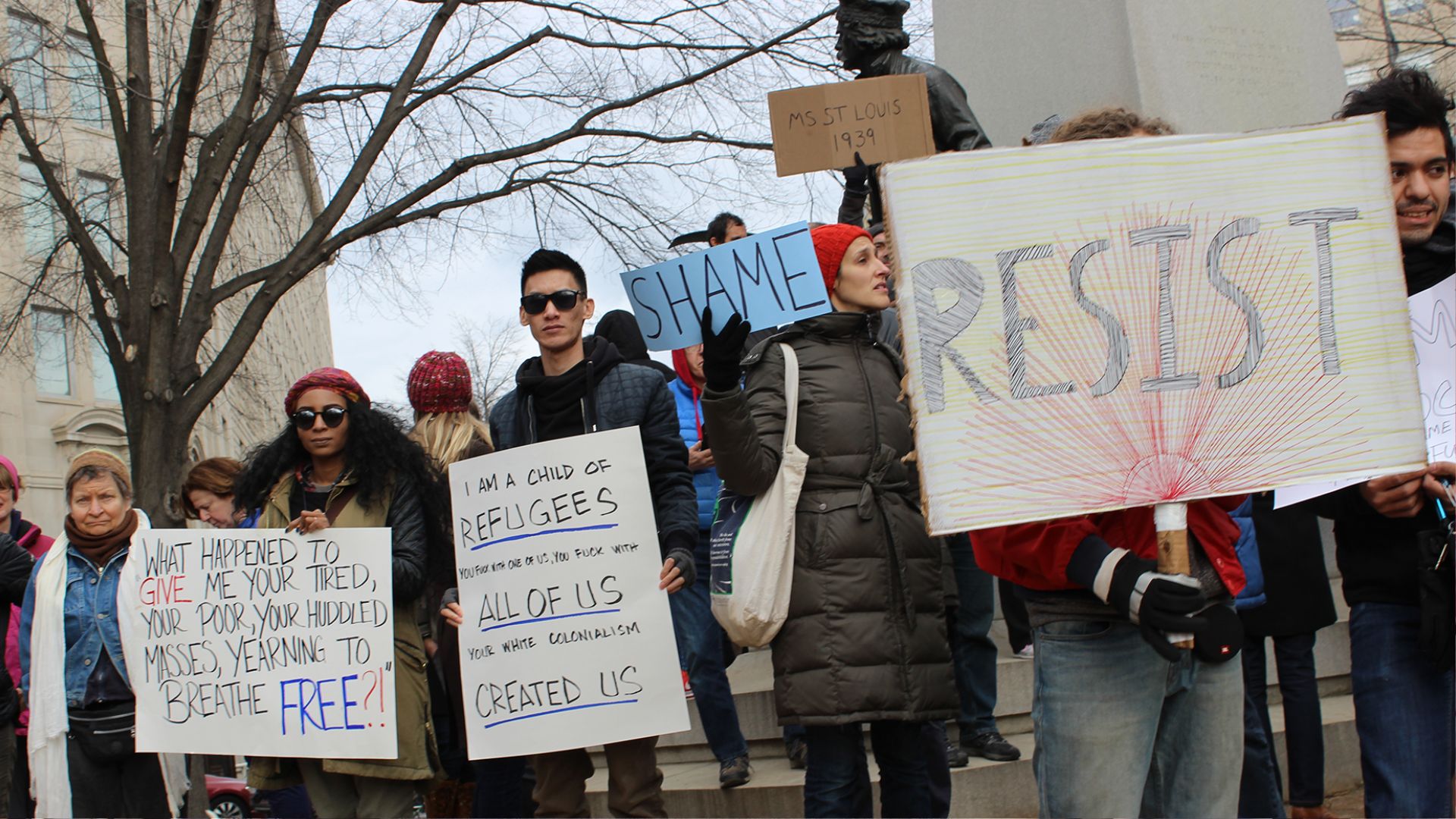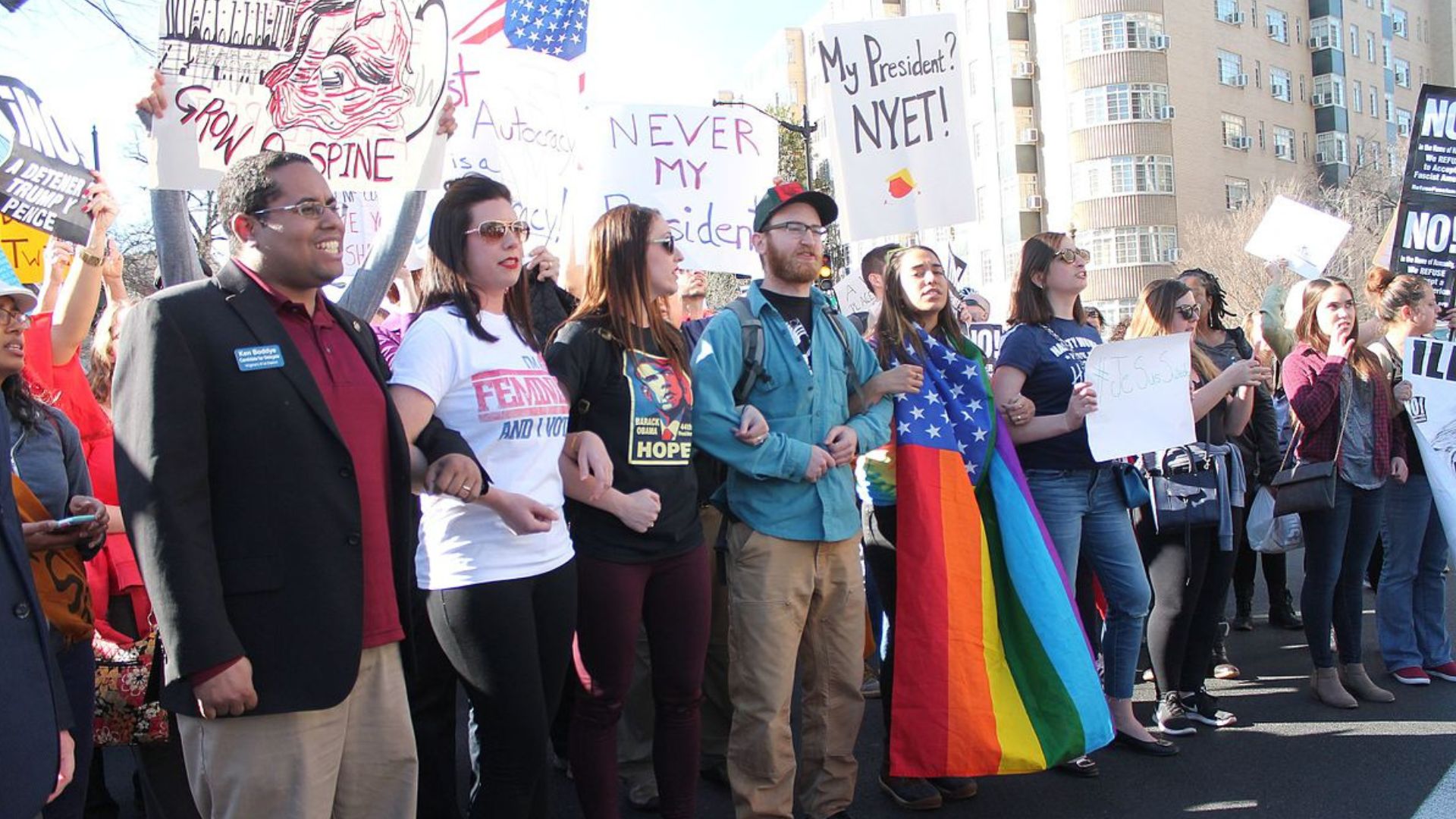Listen to the audio version >>
In the first hundred days of the Trump regime, actions against his juggernaut have swelled from small local demonstrations to nationwide days of action with millions of participants, initiating a movement to defend society against the MAGA assault. In order to understand this movement and its possible future, this Strike! Commentary provides a snap history of how the movement started. The next commentary will recount the emergence of larger-scale mass actions like “Hands Off” and “May Day.” Subsequent commentaries will explore how that movement can halt, roll back, and eventually terminate the MAGA attack on society, exploring what we can expect from Trump and his interaction with the world, the role of workers and unions, and the lessons to be drawn from past movements.

January 29, 2017 – Rally at the White House against the Muslim Ban. Photo credit: Amy J. Pratt, Wikimedia Commons, CC by-SA 2.0.
The weeks after Trump’s election echoed with endless talk about the absence of popular opposition. Since then, opposition has steadily swelled, ranging from self-organized demonstrations in state capitols, to boycotts, to crowd action aimed at Elon Musk and other corporate titans, to days of action at hundreds of post offices, government offices, and politicians’ offices. On April 5 somewhere between three and five million people protested the MAGA assaults at more than 1,300 locations worldwide. How has this movement come to be?
This is not last decade’s Trump Resistance
First stirrings
Less than a week after the election, 100,000 people registered for a call hosted by more than 200 organizations, including the Working Families Party, MoveOn, and Indivisible. More than 40,000 people joined a call announcing a new version of the Indivisible Guide, which played a crucial role in mobilizing the first Trump Resistance.[1] Officials and community groups in many cities instituted trainings designed to teach people how to spot and respond to immigration enforcement actions; a city-sponsored Chicago training in mid-November drew nearly 600 people. On January 18 people in 200 locations, including 100,000 in Washington DC, participated in the People’s March; the event was widely disparaged as diminutive compared to its ancestor, the huge 2017 Women’s March.[2]
Day without an Immigrant
On February 2, thousands of people in Los Angeles, protesting planned deportations, sat down on all lanes of highway 101, halting traffic for more than five hours. In Dallas 1,600 people protested arrests by U.S. Immigration and Customs Enforcement.[3]
A week earlier a call was circulated on social media asking immigrants to skip work, keep their children home from school, and avoid shopping Monday, February 3. That day there were strikes and work closures in 120 cities across 40 states. According to one organizer, 250 businesses nationwide said they closed in solidarity. They included a boutique in Omaha, a coffee shop in Salt Lake City, a used car lot in Baltimore, and an accounting firm in Pasco, Wash. Other businesses partly or fully shut down due to “staffing shortage.” At the Los Angeles Unified school district attendance was 66% Monday compared with 93% for the year as a whole; many teachers reported their classes were almost empty.[4]
Movement 50501
In late January participants in a Reddit page decided to call for 50 protests in 50 states on one day — February 5. They took the name “Movement 50501” and described themselves as “a decentralized rapid response to the anti-democratic, destructive, and, in many cases, illegal actions being undertaken by the Trump administration.” A moderator on the Reddit page, which soon included 173,000 registered participants, said, “We are not an organization. We are a true, blue grassroots movement made up of tens of thousands of Americans—volunteers who passionately believed in saving our democracy.”[5] According to the 50501 website, “In just days, grassroots organizers—without any budget, centralized structure, or official backing—pulled off over 80 peaceful protests in all 50 states.” Twelve days later, tens of thousands of 50501 participants protested on President’s Day, which they dubbed “No Kings Day.”[6]
How many early protests?
In February, while a constant stream of commentaries continued to celebrate or bemoan the absence of visible opposition, the Crowd Counting Consortium, a research team of social scientists that was established in the first Trump regime, counted more than 2,085 protests, compared with 937 in February 2017. They included “major protests in support of federal workers, LGBTQ rights, immigrant rights, Palestinian self-determination, Ukraine, and demonstrations against Tesla and Trump’s agenda more generally.”[7]
Federal workers organize
FUN
In early 2024, a few members of various federal unions began reaching out to contact others through a WhatsApp chat. They came together at the April Labor Notes conference and created an informal organization they called Federal Unionists Network – FUN. In late January, FUN called for a Day of Action to “Save Our Services,” demanding no cuts to vital services, no mass layoffs, respect for union workers’ contracts, and “end the funding freeze.”
They asked federal workers and supporters to take concrete actions:
- On February 19th, wear red, white, and/or blue.
- If you’re a federal worker, take a group photo with your colleagues (or on your own!) with signs about how your work benefits the public. If you’re a community supporter, take a photo with a sign about how you benefit from federal services.
- Post your photos online with the hashtag #SaveOurServices.
- Participate in (and help build) a local rally.
On February 19, federal workers and supporters rallied to “Save Our Services” at over 30 locations around the country, including in New York, Washington, D.C., Atlanta, Philadelphia, Denver, Boston, Boise, Chattanooga, and Chicago. The rallies were held at federal offices like the Department of Health and Human Services, at Tesla dealerships, and in public spaces. They included workers from across agencies; in San Francisco, for example, participants included staff members of the Environmental Protection Agency, the Consumer Financial Protection Board, the Park Service, the Army Corps of Engineers, the National Labor Relations Board, the General Services and Social Security Administrations, and the federal Departments of Education and Housing and Urban Development. In New York, Chris Dols, president of a local union at the Army Corps of Engineers, told a rally:
“The only way we have out of this is if the federal workforce on the front lines puts out a call to the broader labor movement and enters the streets and makes this a political crisis that they cannot manage.”[8]
Many of the rallies were endorsed by local unions of federal workers. National union support, however, was slower in coming. According to well-known labor writer Steve Early, on the eve of the event
The DC-based headquarters of NFFE, the National Treasury Employees, and the International Federation of Professional and Technical Engineers (IFPTE) finally endorsed the “day of action.” The American Federation of Government Employees (AFGE), the largest federal worker union, and National Nurses United (NNU), which represents 15,000 VA nurses—never officially embraced this bottom up effort.[9]
Rather than criticizing federal unions for their insufficient support, FUN took the position that workers should encourage their unions to join more fully in such actions. Over time, unions representing federal employees increasingly supported such protests and initiated them themselves.
AFGE
The largest union representing federal workers, the American Federation of Government Employees, began holding rallies with workers marching around their agency buildings in locations around the country. They invited supporters to join them. AFGE locals held scores of demonstrations at government offices and elsewhere around the country and launched an AFGE Strong Campaign.[10] The union said it had gained more than 20,000 members since January 1. That compares to 7,400 new members in all of 2024.
Educators
On March 4, educators, students, parents, and community allies held a “Protect Our Kids” day of action led by the American Federation of Teachers with events at more than 2000 locations, many featuring “walk ins” by teachers and community members at local schools.[11] On March 19 the AFT and the NEA, America’s largest union, held a second “Day of Action to Protect Our Kids.”[12] A new labor network, Labor for Higher Education, joined demonstrations around the country, such as one at the University of Washington, with 500 demonstrators backed by Auto Workers Local 4121, the University of Washington Academic Workers, which demanded an end to federal cuts and funding freezes for research.[13]
Postal workers
During the week of March 20, thousands of postal workers and their supporters rallied across the nation to protest proposals to dismantle the US Postal Service and cut 10,000 jobs in the next few weeks. There were rallies from Arizona, New Mexico and Texas to Indiana, Missouri and Florida to New York City, Philadelphia and Washington, D.C.[14]
The public had also turned against Trump’s attacks on federal workers. 58 percent of respondents in a Washington Post/Ipsos poll opposed laying off large numbers of federal workers. Just 34 percent approved of Elon Musk’s role in the federal government.[15] At events from Georgia and Wisconsin to Oklahoma and Oregon, House Republicans faced crowds furious about sweeping budget cuts and mass firings of federal workers.[16]
Economic action

Not My Presidents Day demonstrators en route to the White House, Washington, D.C. Photo credit: Elvert Barnes, Wikimedia Commons, CC by-SA 2.0.
Boycotts
A wave of massive but diffuse and difficult to track boycotts quickly sprang up in reaction both to Trump policies and to corporations supporting and implementing them. In January, when Target announced it was ending its diversity, equity and inclusion (DEI) policies, calls for a boycott spread on social media. Twin Cities Pride, which runs the annual Pride festival in Target’s headquarters city Minneapolis, announced it was dropping the company as a sponsor. Black Lives Matter issued calls to boycott the company. A 40-day “Target Fast” aimed to show “Black spending power in real time.” A Latino Freeze Movement called for a boycott on companies that had scaled back their DEI initiatives and asked for participants to not spend money on non-essentials “until they show us that they care about our minority and immigrant populations.” On February 28, a “National Economic Blackout” targeted Target along with Walmart.[17] Target, Walmart, McDonald’s, Lowe’s, and Amazon were hit by a series of rotating boycotts.[18]
While the effects of these boycotts on their targets are difficult to ascertain, their extent of participation appears to be extraordinary. 36% of Americans told Harris pollsters they are or will be participating in “the boycotts that have been making headlines over the last few weeks,” making the boycotts one of the largest if not the largest protest in American history. 53% of gen Zers, 46% of millennials, 53% of African Americans, and 51% of Hispanics said they were boycotting. Their top reason was: “They want to show companies that consumers have economic power and influence, and express their dissatisfaction with current government policies.” Nearly half of those boycotting (46%) pointed to companies rolling back their diversity, equity and inclusion (DEI) policies as a reason behind their boycott.[19]
Tesla Takedown
As Elon Musk rapidly emerged as the implementer of many of Trump’s most unpopular policies, local actions began popping up at Tesla showrooms around the country. By mid-February, demonstrations with more than a hundred participants were occurring in New York, San Francisco, and other cities. By early March, an action in Tucson drew 1,800. At a livestream event March 20, a “day of action” was announced for March 29. Rallies were held in front of nearly every Tesla showroom in the US and many around the world – 250 sites in all, according to the Tesla Takedown website. There were about 750 protesters outside of a Tesla location in Rockville, Maryland; hundreds at a protest in Boston; and 200 in Chicago.[20]
These early anti-MAGA actions seemed to have little impact on the public, the media, or the Trump administration. Within weeks, however, such social self-defense would grow from thousands to millions.
The next Strike! Commentary will examine the rise of mass action in the streets in response to Trump’s developing autocracy, notably the Hands Off and May Day days of action. Subsequent commentaries will discuss how this movement might develop the power it needs to overcome the MAGA juggernaut.
[1] Sarah D. Wire, “The Donald Trump resistance is ready for when Democrats are done grieving,” USA Today, November 22, 2024. https://www.usatoday.com/story/news/politics/elections/2024/11/22/trump-resistance-groups-democrat-movement/76414325007/
[2] “People’s March,” Wikipedia, Wikipedia. https://en.wikipedia.org/wiki/People’s_March
[3] “Marchers protesting planned deportations block major freeway in Los Angeles,” AP, US News, February 3, 2025. https://apnews.com/article/immigration-ice-protests-los-angeles-california-dallas-ecf1afef642ffff40117f88641c8605f?ref=meditations-in-an-emergency.ghost.io
[4] Andrea Castillo, Malia Mendez, Cindy Carcamo & Gustavo /Arellano, “Businesses close, children skip school for ‘a day without immigrants’ protest,” Los Angeles Times, February 3, 2025. https://www.latimes.com/politics/story/2025-02-03/businesses-close-children-skip-school-for-a-day-without-immigrants-protest
and
Rivera Sun, “Resistance to Trump is everywhere – inside the first 50 days of mass protest,” Waging Nonviolence; People Powered News & Analysis, March 13, 2025. https://wagingnonviolence.org/2025/03/resistance-to-trump-is-everywhere-inside-the-first-50-days-of-mass-protest/
[5] Eloise Goldsmith, “ ‘Be Loud. Stay Peaceful’: Anti-Trump ‘Movement 50501” Protests Take Place Nationwide,” Common Dreams, February 5, 2025. https://www.commondreams.org/news/movement-50501-protests
[6] https://www.fiftyfifty.one
[7] Erica Chenoweth, Jeremy Pressman, and Soha Hammam, “Resistance is alive and well in the United States,” Waging Nonviolence, March 19, 2025. https://wagingnonviolence.org/2025/03/resistance-alive-well-us/
[8] Steve Early, “On National Day of Action: Federal Union Rank-and-Filers Protest Musk & Challenge Their Own Leaders,” BeyondChron, February 24, 2025. https://beyondchron.org/on-national-day-of-action-federal-union-rank-and-filers-protest-musk-challenge-their-own-leaders/
and
“Save Our Services Day of Action,” Action Network, February 19, 2025. https://actionnetwork.org/events/save-our-services-day-of-action
[9] Ibid. https://beyondchron.org/on-national-day-of-action-federal-union-rank-and-filers-protest-musk-challenge-their-own -leaders/
[10] “AFGE In The News,” AFGE, April, 2025. https://www.afge.org/media-center/afge-in-the-news/?link_id=23&can_id=45c1bd607484cf87bc6bcbbee7ab1154&source=emailsss-&email_referrer=&email_subject=96ee7202ac2bcb7bf1b97126dc17f42a08b6ec4f&& and “We Are AFGE Strong,” Ibid. https://www.afge.org/afgestrong?link_id=24&can_id=45c1bd607484cf87bc6bcbbee7ab1154&source=email-&email_referrer=&email_subject=96ee7202ac2bcb7bf1b97126dc17f42a08b6ec4f&&
[11] Nicole Gaudiano, “AFT Holds 2,000 Events, Activities During March 4 Day of Action to ‘Protect Our Kids,’ “ AFT Education, Healthcare, Public Services, March 4, 2025. https://www.aft.org/press-release/aft-holds-2000-events-activities-during-march-4-day-action-protect-our-kids#:~:text=WASHINGTON—Educators%2C%20students%2C%20parents,and%20Elon%20Musk’s%20cruel%20and
[12] “Protect our Kids,” Ibid. https://www.aft.org/ProtectOurKids?link_id=21&can_id=45c1bd607484cf87bc6bcbbee7ab1154&source=email-&email_referrer=&email_subject=96ee7202ac2bcb7bf1b97126dc17f42a08b6ec4f&&
[13] “HANDS OFF! OUR HEALTHCARE, RESEARCH, JOBS,” LABOR FOR HIGHER EDUCATION. https://www.labor4highered.org/?link_id=10&can_id=45c1bd607484cf87bc6bcbbee7ab1154&source=email-workers-fightback-for-climate-and-jobs-labor-network-for-sustainability-newsletter-90&email_referrer=email_2636534&email_subject=workers-fightback-for-climate-and-jobs-labor-network-for-sustainability-newsletter-90
[14] “US Mail Not For Sale –Day of Action,” APWU. March 20,2025. https:/apwu.org/day-of-action?link_id=22&can_id=45c1bd607484cf87bc6bcbbee7ab1154&source=email-&email_referrer=&email_subject=96ee7202ac2bcb7bf1b97126dc17f42a08b6ec4f&&
[15] Jessica Piper, “Warning signs for Trump in new polling,” POLITICO, February 21, 2025. https://www.politico.com/news/2025/02/20/cnn-washington-post-polls-trump-approval-00205169?link_id=4&can_id=45c1bd607484cf87bc6bcbbee7ab1154&source=email-workers-fightback-for-climate-and-jobs-labor-network-for-sustainability-newsletter-90&email_referrer=email_2636534&email_subject=workers-fightback-for-climate-and-jobs-labor-network-for-sustainability-newsletter-90
[16] Scott Wong, Syedah Asghar, Sahil Kapur & Ben Kamisar, “At town halls, Republicans feel the heat from Trump and Musk’s firing and cutting spree,” NBC News, February 21, 2025. https://www.nbcnews.com/politics/congress/town-halls-republicans-feel-heat-trump-musks-firing-cutting-spree-rcna193164
[17] Betty Lin-Fisher, “What are the results from the Feb 28 economic blackout? See what data shows,” USA TODAY, March 6, 2025. https://www.usatoday.com/story/money/2025/03/04/did-feb-28-economic-blackout-work/81191601007/
[18] “WE FIGHT BACK! FEBRUARY BOYCOTT-AMAZON, WALMART, TARGET, MCDONALDS, LOWES, DEI SUPPORTERS: COSTCO, ALDI. ACROSS THE U.S.A. 2/2025, Facebook, https://www.facebook.com/photo/?fbid=10234475701409389&set=a.10207693575432978
[19] Lauren Aratani, “A quarter of US shoppers have dumped favorite stores over political stances,”
The Guardian, February 18, 2025. https://www.theguardian.com/us-news/2025/feb/18/shoppers-political-boycotts-spending-patterns-poll and
Rivera Sun, “Resistance to Trump is everywhere – inside the first 50 days oof mass protest,” Waging Nonviolence, March 13, 2025. https://wagingnonviolence.org/2025/03/resistance-to-trump-is-everywhere-inside-the-first-50-days-of-mass-protest/
[20] Dara Kerr and Edward Helmore, “Protests hit Tesla dealerships across the world in challenge to Elon Musk,” The Guardian, March 29, 2025. https://www.theguardian.com/world/2025/mar/29/tesla-protests-elon-musk-doge

